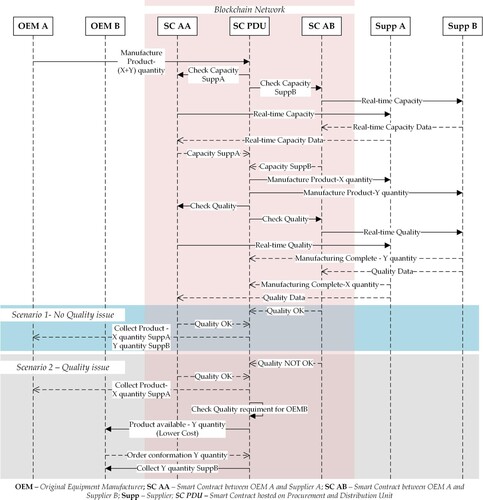ABSTRACT
Blockchain technologies can support traceability, transparency and trust among participants. This has primarily been explored in established supply chains and not in the growing use of business networks or ecosystems, which is a notable limitation since supply chains typically are organised with a dominant actor that ensures common information systems and standards that negate blockchain benefits. Hence, this study explores the design of a blockchain-based collaborative framework for resource sharing using smart contracts. These are particularly well-suited for supporting operations in broader networks or ecosystems beyond supply chains with established collaborations and hierarchies. Based on a systematic literature review, a demonstrator framework was developed for stakeholder interactions through a procurement and distribution unit backed with blockchain technology. The framework consists of (a) network architecture to demonstrate partner interactions; (b) rules for network working principles based on supply collaboration requirements; (c) UML diagram to define smart contract interaction sequence; and (d) algorithm for smart contract network verification and validation. Applicability of these smart contracts was verified by deployment on an Ethereum blockchain. The demonstrator framework ensures quality and data authenticity in supply networks, so it is useful for effective resource utilisation in networks where outsourcing and production surpluses are major issues.
1. Introduction
Several studies have highlighted the potential advantages of distributed ledger technologies, such as blockchains, since they can increase security, traceability and transparency and hence enhance trust among supply chain partners, for example, (Karakas, Acar, and Kucukaltan Citation2021). There is also evidence of demand for more sustainable products and supply chains by providing trustworthy information about the origin of materials (Grzybowska and Awasthi Citation2020). The transparency also helps reduce costs and time delays (Pournader et al. Citation2020; Gaur and Gaiha Citation2020). Much of the blockchain-related supply chain literature explores these benefits to partners in established supply chains with dominant actors that control processes and relations (Duong and Chong Citation2020). This is limiting in scope since, in such supply chains, the extensive use of information sharing systems (e.g. ERP) means that the added value of adopting blockchain technology typically is marginal. There are also supply networks and ecosystems with more fluid networks of partners linked by flows of data, services and money. Relationships combine aspects of competition and collaboration, often involving complementarities between products and capabilities that evolve over time, as discussed by Fuller, Jacobides, and Reeves (Citation2019) and Graça and Camarinha-Matos (Citation2017), and supported by the emergence of digital platforms (M. Li et al. Citation2021). Sharing information among participants outside of the established supply chain, such as third-tier suppliers, remains essential, but the information flow cannot adopt the same rigid and hierarchical structure similar to established supply chains. Blockchain technology can improve value propositions through offerings based on smart contracts that allow for transparent and autonomous actions between participants within the broader network (Dolgui et al. Citation2020). This mitigates risks of manipulation and error while retaining exclusivity and providing an incentivizing mechanism. However, such mechanisms for collaborative networks function within the framework of an established supply chain remains unclear (Ribeiro da Silva, Angelis, and de Lima Citation2019). Therefore, this study addresses the overall research question: How do blockchain-based smart contracts promote collaboration as well as resource sharing and utilisation in supply networks? The investigation is operationalised through a literature review of existing solutions, followed by the development of a collaborative network framework. It focuses on information flow between partners in a blockchain-based network and is presented by its key characteristics of structure and rules for smart contract development. The framework is demonstrated and tested by deploying the developed smart contract on an Ethereum blockchain network, thus assessing the suitability of smart contracts and their applications. In doing so, the study identifies how blockchain technology-based smart contracts incentivize collaboration. It also explores support for a broadened inclusion of partners to a more collaborative supply partnership and business ecosystems.
The rest of the paper is structured as follows. First, the relevant literature on blockchains, smart contracts and collaborative supply chains is presented. This is followed by a methodology section that describes the steps taken to develop the framework. Next, deployment and validation of the smart contract on the Ethereum blockchain network are explored. Finally, identified framework implications are discussed, while the concluding section highlights theoretical contributions and managerial insights gained as well as future research directions. It can be noted that the study is an extension of the paper by Agrawal, Kalaiarasan, and Wiktorsson (Citation2020) presented at IFIP International Conference on Advances in Production Management Systems (APMS 2020).
2. Research background
In introducing the research background, we first cover key blockchain and smart contract concepts, followed by a structured literature search to identify articles that demonstrate smart contract applications in manufacturing supply networks.
2.1. Blockchain for supply chain collaboration
Extensive research has shown that supply chain collaboration provides several advantages, ranging from increased knowledge sharing to broader access to products and expertise (Jraisat et al. Citation2021). Supply chain parties collaborate and manage organisational processes and resources to achieve efficient and effective flows (Tang et al. Citation2021). While collaborations have many dimensions, information sharing and alignment is key component in coordination across the supply chain (Dubey et al. Citation2021). This has led to the broad adoption of information sharing systems between parties in established and vertically integrated supply chains, especially to enable intelligent manufacturing (Zhou et al. Citation2021). This improves performance by enabling real-time information transfer, coordinated inventory management, foster flexibility and adaptability to demand changes across the supply chain (Dolgui and Ivanov Citation2021). For sustainable operations, or those seeking to adopt Industry 4.0, information sharing and collaboration across the supply chain is a critical capability (Cricelli, Greco, and Grimaldi Citation2021; Gebhardt et al. Citation2021). However, this requires a degree of trust since information sharing leads to risks of manipulated data, loss of know-how and expertise, weakening of bargaining power and information disadvantage (Yu and Goh Citation2014). Blockchain technologies are useful in these instances because they provide information security and stability (Dubey et al. Citation2020; Cui, Gaur, and Liu Citation2020). Stakeholders of a blockchain maintain the ledger to provide transparency and traceability to all interactions within the set boundaries of the supply network and broader ecosystem or network (Kochovski et al. Citation2019).
There are four key characteristic elements of blockchain technology. The first is a distributed network structure with a common shared ledger without a single authority maintaining and validating the ledger. Instead, each partner shares a common ledger over a decentralised distributed network that records all transactions. This makes blockchain suitable in supply chains where validation is difficult to ensure, see for instance (Saberi et al. Citation2019). The second characteristic is data immutability, which is achieved through a cryptographic function and block-linking mechanism that ensures traceability of products and accountability of transactions. The third blockchain characteristic is consensus, which is the process of reaching an (automatic) agreement among all involved partners for each transaction by verifying it with each individual copy of the shared ledger. This eliminates the need for central authority, helps reduce fraudulent and inaccurate transactions and overcomes Byzantine faults (Saberi et al. Citation2019). Lastly, there is a provision of smart contracts, which contain transaction rules agreed upon among partners, written and stored as computer programs over the network (Saberi et al. Citation2019). It allows for greater blockchain value capture through the establishment of set transactions based on unique conditions (Angelis and Ribeiro da Silva Citation2019), which is a valuable characteristic in supply networks with more relationships and roles. The role of smart contracts is discussed further in the next section.
2.2. Smart contracts
As blockchain technology has evolved from transaction-based logic to value pursuit through customisation (Govindan et al. Citation2022), smart contracts have become more prominent. The concept of smart contracts was introduced in the mid-1990s, long before blockchain application (Szabo Citation2016), as ‘a set of promises, specified in digital form, including protocols within which the parties perform on these promises.’ In practice, smart contracts capture algorithmic contractual elements and encode them in computer programs, along with cryptographic methods to protect agreements from tampering. This makes them self-verifiable, self-enforceable and tamperproof (Manimuthu et al. Citation2021). The smart contracts have several functions. They automate the transaction process, manage user agreements, facilitate utility to other contracts, ensure fair play among partners and support asset transfer as soon as a predetermined agreement is met (Manupati et al. Citation2022). Smart contracts are stored on the blockchain network, each marked with a unique address. They are designed by first identifying the agreement or desired outcome each partner wants to achieve. The conditions to be validated are then set through the contract. This is followed by coding and employing them over different blockchain nodes. Validation is conducted through a consensus mechanism, which then updates the ledger (Swan Citation2015).
The specific nature of validation in a smart contract depends on the type of blockchain network with which it is associated, for instance, public or private, permissioned or permissionless, (Swan Citation2015). The network partners have mutual understanding; thus, consensus protocols for the validation of the smart contracts are flexible in their application. The protocols may be transaction-specific or through a chosen governance body. Partners can use a third-party (service provider) to validate contracts and post transactions (Agrawal et al. Citation2021). For supply network collaborations, smart contracts allow stakeholders to retain the flexibility of differentiated relations and customisation within a given ecosystem. The exact type of contract adopted depends on the network configuration, product type, extent of traceability and transparency, underlying business model and, as also explored in this study, supply collaboration for improved resource utilisation (Dolgui et al. Citation2020).
2.3. Blockchain and smart contracts
Several studies have highlighted the particular roles of smart contracts in supply networks, for example, (Saberi et al. Citation2019; Wang, Yan, and Wang Citation2021; Liu, Li, and Jiang Citation2021). These cover a broad range of issues, such as traceability, product safety, supply disruption, sustainability, demand forecasting, scheduling, visibility, tariffs, compliance violation, transparency, certification, audits and transaction settlements (Ivanov, Dolgui, and Sokolov Citation2019; Vatankhah Barenji et al. Citation2020; Saberi et al. Citation2019). In blockchain-based supply networks, smart contracts validate the operations’ fulfilment to ensure progress and detect deviations. Using a decentralised and distributed network configuration and shared ledger, smart contracts are suited to identify fraudulent transaction-accountable partners and ensure the provenance of materials and fair trade. Over a blockchain network, data is related to the specific location and condition (e.g. temperature) of assets along with timestamp, provenance, quality checks, transfer of ownership and transactional status, all of which can be stored and accessed at any time (Dubey et al. Citation2020). This expedites and automates auditing and regulatory activities through trust and confidence in the documentation, saving both time and resources by eliminating the use of an intermediary and disrupting traditional governance procedures (Shermin Citation2017). However, the automated nature of customisable smart contracts may also paradoxically reduce flexibility in a supply network, since the contracts have to be mutually agreed upon (Kim and Laskowski Citation2018). Moving from a manual process to an automated real-time process means that the rules and regulations of the contracts need to be scrutinised in great detail before deployment (Swan Citation2015).
To further explore the literature on blockchains and the use of smart contracts in production supply networks, a systematic literature search was conducted on Scopus. With the search string – ‘(TITLE-ABS-KEY ((“supply chain”) OR (logistic*)) AND ((smart AND contract) AND (blockchain) AND ((production) OR (manufacturing))))’ different articles were filtered based on their scope and contribution in production logistics supply chain and then analysed. Search was limited to the journal article, published in English and in subject areas engineering and business, management and accounting. Initial search resulted in 295 articles. In the first sorting step, the titles, keywords, abstracts were analysed and the list was filtered to 61 articles. Later, the content of these identified articles were reviewed by a group of four researchers to identify the most relevant articles that discuss about smart contracts and their application in blockchain technologies. The identified literature on blockchain applications is listed in .
Table 1. Blockchain and the use of smart contracts in different types of supply chains.
As the table shows, blockchain-based smart contracts have been employed in various settings, with a focus primarily on cost benefits gained through visibility and traceability. Smart contracts have the potential to enhance the value capture and collaboration in extended supply chains or ecosystems, but there is little guidance in the literature as to how such smart contracts should be designed and deployed. Thus, there is a need for a specifically developed framework involving different elements, including smart contract rules and algorithms that support resource utilisation in the supply network, promote collaboration and facilitate information sharing. Such smart contracts can promote trust, ensure effective order distribution for better resource utilisation and facilitate consumption of surplus products. To demonstrate the framework and smart contract functionality, the study is inspired from the established 4 + 1 architectural view model (Kruchten Citation1995) that is widely used for describing software-intensive systems. To further explore how smart contracts promote collaboration in supply networks, the following section describes the development of a collaborative network framework.
3. Methodology
Following the research question, the study adopted a systems perspective (Arnold and Wade Citation2015) because it is the sharing of information between units (partners) that are explored. It is further inspired from the established 4 + 1 architectural view model (Kruchten Citation1995) to explore the various elements within a system. Several studies have adopted a systematic approach for developing frameworks, including actor interaction, rules for interaction and functions; for instance, Salah et al. (Citation2019), Westerkamp, Victor, and Küpper (Citation2020), Kumar et al. (Citation2020) and Li et al. (Citation2020). This study employed a similar five-step methodology, as shown in , to explore the research question. We specifically developed a framework that incorporates smart contracts designed in a comprehensive and systematic manner to facilitate collaboration.
Figure 1. Five steps methodology employed in the study.
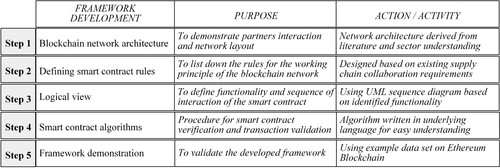
Step 1: As the first step, we explored blockchain network architectures to identify how different partners interact over a large network. A network architecture virtually represents the network configuration and maps out its structure using symbols and line connections. The virtual presentation helps users identify and understand network connections. The architecture characteristics are based on the literature review and understanding of the industry on information flows and node interaction characteristics (Agrawal et al. Citation2021), the latter of which reveals how the partners communicate over the network without privacy and data security risks.
Step 2: Following the architecture identification and illustrated network diagram, smart contract rules were defined that set the working principles of the framework. The rules facilitate resource sharing during the production and distribution phases based on existing supply collaboration requirements. Unlike physical contracts, smart contract rules are written in programming languages using conditional statements. They are usually deployed over a blockchain with the smart contract programme logic contained within a block. A block combined with messages concerning a particular smart contract acts as input or output for the smart contract programming logic and further points to another code. Identifying smart contract rules helps to better understand the smart contract algorithm and the specific rules that govern the transactions of the partners over the blockchain network.
Step 3: After defining the interactions and rules for working principles, a logical view of the blockchain network was defined through a UML sequence diagram. The diagram covers the functionality and sequence of the smart contract interactions. This provides a basis for understanding the structure and organisation of both technical and non-technical audiences, as also seen in several other studies (e.g. Salah et al. Citation2019; Westerkamp, Victor, and Küpper Citation2020; Kumar et al. Citation2020).
Step 4: The fourth step defined algorithms that outline smart contract working principles to capture information generation and verify information over the blockchain network. The study’s defined algorithm includes a smart contract for the internal data management system within a manufacturing unit, a blockchain channel between two partners and a procurement and distribution unit (PDU) that caters to a set of partners involving buyers and a supplier. Based on this, smart contract logics were written to facilitate the understanding, translation and adoption of most programming languages.
Step 5: For the final step, the developed smart contract algorithm was written in Solidity language and deployed on an Ethereum blockchain network using the Etherscan interface. Ethereum is a public and open blockchain in which each action is recorded in the transaction history, and anyone in the network can access transactions. Ethereum has proven to be practical for smart contract development, deployment and validation over a blockchain network, as argued by Salah et al. (Citation2019) and Westerkamp, Victor, and Küpper (Citation2020). Contract interconnectivity was tested by chronologically deploying several interlinked smart contracts along with test data to check functionality and visualise their working in a supply network setting. There are other popular blockchain platforms, such as Hyperledger Fabric, that could be used for smart contract testing and deployment, but the smart contract logic of this study remains the same irrespective of blockchain platform. Lastly, as data over the blockchain network were stored in an encrypted format, test transactions were visualised through the Etherscan interface to verify transaction authenticity. As noted by Alzahrani and Bulusu (Citation2020), it requires a significant effort to develop a full-fledged testbed that incorporates all proposed features, interactions and structures to simulate and evaluate blockchain network performance. Simulation models and tools do not have the functionality to incorporate all relevant blockchain aspects, which makes interfaces such as Etherscan relevant platform tools for block exploration and analysis.
4. Collaborative network framework
In exploring the research question, a collaborative network framework was developed to illustrate how smart contracts can support collaborative efforts. We present next the overall structure of the framework using a network diagram that includes actors and interactions. Then the operationalisation of the framework is introduced by showing the steps for smart contract execution, the actor interaction with the smart contract, and how operations are conducted over the blockchain network. The details of the information validation are described by the algorithms that govern recordings of sensor readings to the ledger in the data management system. The smart contracts framework was employed in a case example.
4.1. Network diagram
Interactions in a full-fledged business ecosystem are quite complex, and overly complicated to visually demonstrate in a single diagram. Therefore, for simplification, we demonstrate the identified partner interactions shown in with an example that includes two suppliers (Supplier A, Supplier B) and two original equipment manufacturer buyers (OEM A, OEM B). The figure shows all information flows in the blockchain. It highlights the distributed management system as well as the network channel division. We assume that the OEMs procure the same kinds of products from suppliers A and B. With certain modifications, the framework can be replicated and scaled up following similar network rules, with the inclusion of multiple collaborative companies from the same or different supply tiers to fit with real-world and highly complex supply networks. OEM A and Supplier A are connected through Channel AA on the blockchain network. Transactions are written on a ledger shared between them, which is secure and private, with restricted outside accessibility. The smart contract(s) (SCL1) hosted at Channel AA accesses information from the internal data management system at Supplier A and OEM A and validates the transactions. Similarly, OEM A is connected to Supplier B through Channel AB, OEM B is connected to Supplier A through Channel BA and OEM B is connected to Supplier B through Channel BB. Each channel has its own ledger and smart contract(s) with similar rules (SCL1) and restricted access. The network division to different channels allows for the data partitioning mechanism. In a private blockchain network, a channel is an overlay that facilitates data isolation and confidentiality. Each channel hosts its own smart contract(s) and stores data on the distributed ledger in an encrypted form. Only authorised nodes (within or outside) of the channel have ‘read’ accessibility to the ledger data. This facilitates data privacy and ensures secure data management. Partners over a channel are governed by channel rules as well as common network rules. The channel rules include the transaction and access rights of each partner and the extent to which they interact over the particular channel. Channel accessibility and membership are managed by the blockchain service provision. Note that the term or the concept of ‘channel’ is often used in Hyperledger Fabric network, which is a well-known permissioned blockchain. This network sub-division into channels can be realised in any permissioned blockchain. The PDU is connected to all partners to access ‘demand data’ and ‘products ready for distribution data’ through the channels. It hosts a different kind of smart contract (SCL 2) that accesses channels AA and AB to only collect capacity data for demand distribution and overall quality data for produced goods. Lastly, a third-party auditor can, with mere read functionality, audit all transactions over the blockchain to ensure regulatory compliance.
Figure 2. Illustration of supply chain partner interactions over a blockchain-based collaborative network.
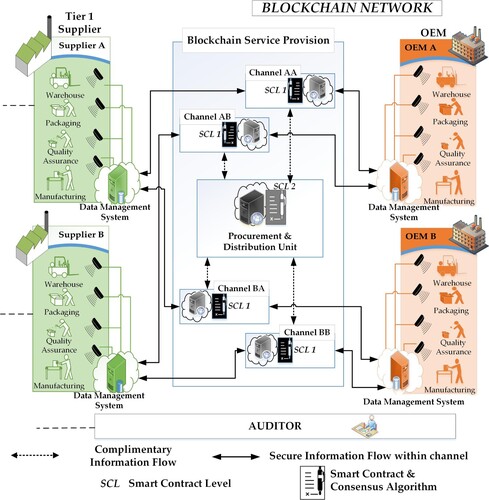
4.2. Capacity- and quality-based smart contracts
Here, we demonstrate the validity of capacity and quality-based smart contracts. Using a blockchain with the developed framework ensures privacy, data security and promotes trust. Other benefits of the smart contract PDU include preventing fraudulent transactions, overbooking of capacity and facilitating distribution of excessive resources. It also enables defining customised transaction rules as agreed upon among the partners. The shared ledger on the PDU accesses real-time data on the capacity and quality of individual suppliers from their channels, including data on the total number of finished products with critical, major and minor defects – calculated on individual channels using quality data from supplier. Capacity and quality-based smart contracts are created and hosted on the PDU. A new demand from a buyer (OEM) triggers the execution of capacity-based smart contracts. This demand data includes order quantity, lead-time, list of priority suppliers and required order machine-hours. The PDU accesses real-time capacity data of suppliers from different channels. The smart contract checks and evaluates the order fulfilment capability for each supplier following the priority list shared by the buyer and distributes orders based on available capacity. The transaction is recorded on the ledger hosted on PDU once all demand is distributed and the supplier awaits payment confirmation that requires validation from a quality-based smart contract. Quality-based smart contracts are executed once a supplier broadcasts ‘production complete’ notification on the network. The PDU then accesses quality data of the manufactured product along with the Acceptable Quality Level (AQL). The smart contract checks the produced quantity against the ordered quantity and compares the quality data with the buyer required AQL. If the order fulfils all the criteria, payment confirmation notification is communicated to the previous smart contract and the supplier delivers the required products to the buyer. However, if the order does not meet the required criteria, payment is not confirmed and the order quantity along with the AQL level is broadcasted to the open market to check if the order fulfils the demand of any other potential buyer. With further developments, the contract can also include factors related to multi-criteria decisions, such as sustainable triple bottom line conditions.
4.3. Logical view of the blockchain network
The UML sequence diagram (see ) shows the smart contract functionality for supply network collaboration. It demonstrates the interaction of actors with the smart contract and how operations are conducted over the blockchain network. In the vertical time axis (lifelines), the diagram shows the messages exchanged between objects (supplier/OEM) and the system (smart contracts). In the framework, a sequence of operations and interactions occurs among Supplier A, Supplier B, OEM A and OEM B with smart contract SC AA – the smart contract hosted on channel AA; SC AB – the smart contract hosted on channel AB; and SC PDU – the smart contract hosted PDU. With an example product order of (X + Y) quantity, the diagram highlights possible interactions and message exchanges to distribute orders among suppliers, and based on the quality data of the finished product, how orders are dispatched to suppliers. Scenario 1, in this case, explains the SC PDU smart contract action when there is no quality issue in the finished product, and Scenario 2, when there is a quality issue in the finished product.
4.4. Smart contract algorithm
For each stage, information is validated using different smart contracts to ensure information visibility and appropriate procurement and distribution. At the manufacturing units, the smart contract facilitates data acquisition and validation of sensor readings. In the absence of a blockchain network, it is the responsibility of each partner to ensure that data generated through the sensors and stored in the data management system is accurate and timely. Algorithm 1 () describes the process that governs sensor reading recordings to the ledger in the data management system. The sensors are designed to check product quality and process time against the provided specifications. Smart contract rules can also be generated for other types of sensors. Once the initial state of the contract is established, the smart contract checks and confirms the transaction validity using the unique identification number (ID) of the sensor/node, given that the requesting sensor is already registered in the system. The contract then checks the sensor reading against the process specification, including an error margin. If the product conforms to the specifications set, a quality approval notification is generated and stored. If it does not conform, a quality issue is recorded instead. Lastly, the product ID and process start and end times are recorded. Algorithm 2 (in ) proposes rules for a smart contract on the blockchain ledger in a buyer–supplier channel. It registers process efficiency and product quality from the manufacturing unit of the supplier. This algorithm accesses quality and process time data from the supplier data management system and records the process efficiency (to evaluate machine-hour capacity) and defect percentage of finished goods (to evaluate AQL levels). Efficiency is calculated by checking each process separately.
Figure 4. Algorithm 1 for data acquisition and Algorithm 2 for collecting process efficiency and quality data.
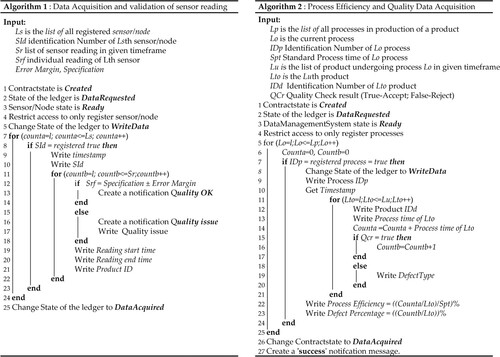
Algorithms 3 and 4 () propose rules for the smart contract hosted on the PDU. Algorithm 3 describes the rules for order distribution among suppliers. It takes inputs from buyers in the form of demand quantity (D), order lead-time (in days) (Ld), list of priority suppliers and required order machine-hours (RMHd). Furthermore, it retrieves the machine-hour capacity data (per day) of each supplier (MHCp) and the total machine-hours for non-pre-emptive orders already in the queue (RMHp). The MHCp is calculated by multiplying the process efficiency data by the total number of machines in the manufacturing unit and total working hours/day. The algorithm multiplies MHCp of the first priority supplier with Ld to obtain the total possible machine-hour capacity. It then substrates RMHp to obtain the actual machine-hour capacity of the first priority supplier. Order quantity equivalent to the actual machine-hour capacity goes to the first priority supplier, and the remaining quantity (RMHd-actual machine-hour capacity of the first priority supplier) goes to the second priority supplier following the same rule, and so on. Meanwhile, algorithm 4 checks the produced order (finished goods) quality level by verifying the quality data retrieved from suppliers’ manufacturing unit through the channel ledger and checks this against the OEM (buyer) AQL. If the finished goods fulfil buyer quality requirements, the purchase is successful and the buyer transfers money to the supplier. By contrast, if the finished goods fail to fulfil the buyer quality requirements, the contract seeks other buyers requesting finished goods and with a higher AQL (i.e. buyers who accept products with lower quality requirements).
Figure 5. Algorithm 3 rules for order distribution among suppliers and Algorithm 4 for produced order distribution among OEM.
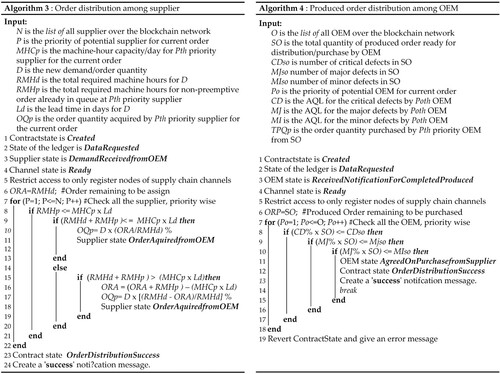
4.5. Scenario demonstration with smart contract deployment and verification
Using a Business Process Model and Notation (BPMN) diagram, we further demonstrate in the process model for a simple scenario. The scenario starts with Step 1- deployment of the collaborative model, which includes adding supplier’s details such as, capacity, previous known quality, preference level, etc. Step 2 is initiated when a buyer makes an order. The buyer model is deployed and shares demand data, including expected price, quantity, lead-time and quality (AQL). Once the demand is broadcasted, available hours of the first preferred supplier are checked. If hours are not available the next supplier is selected from the list. If supplier matches and hours align, price is calculated, and then the process waits for buyer payment confirmation. If the buyer deposits the payment, the amount is withheld in the account until the end of the process, which also awaits supplier production and quality control. The supplier then deploys the quality model to confirm product quality. It sends the quality details to the buyer’s contract, and if the quality does not match a refund process is triggered, and the process ends with the buyer being refunded the full amount. If the product quality is accepted by the buyer, delivery is confirmed, which triggers the release of payment to the supplier’s account and the entire process ends.
Figure 6. BPMN diagram demonstrating the steps for smart contract deployment and verification.
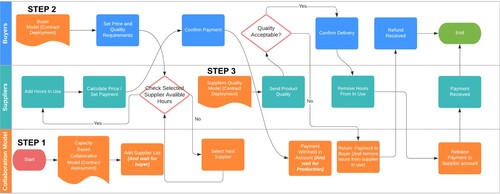
The proposed smart contracts were further deployed on Ethereum blockchain using ‘Görli Test Network’ on the Etherscan interface. The network uses a proof-of-authority consensus algorithm which is a modified form of proof-of-stake. It is a reputation-based consensus algorithm that leverages and relies on the value of identities. The algorithm requires individuals to get their identities verified in the real-world. This makes it suitable for private blockchain networks in supply chain applications. As per the Ethereum website, the average time to mine one block is about 12 seconds. The block time is set as a constant to protect the network’s security when new miners join. However, in a private blockchain network for supply chain applications the mining time can be significantly reduced as the private network comprises of known participants with a certain degree of trust. Examples of transactions for supplier selection and order distribution are shown in Figures (see Appendix for the complete code). The contract development and later deployment and verification require several steps. A smart contract is initially created on the PDU node, in this case, an Etherscan account, and hosted as a new block of the Ethereum blockchain network, as shown in .
Figure 7. Smart contract created on the PDU node and hosted as a new block of the Ethereum blockchain.
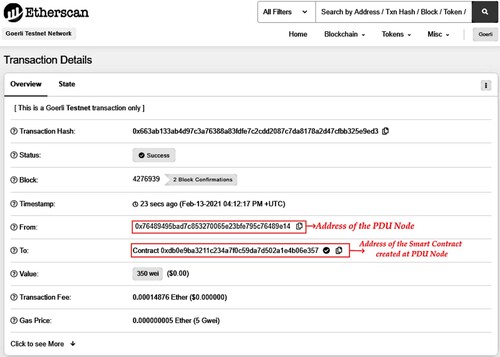
Figure 8. (A) Screenshot of the ‘Write Contract’ tab for inputting parameters. (B) Screenshot of the ‘Read Contract’ tab for reading the results of a smart contract.
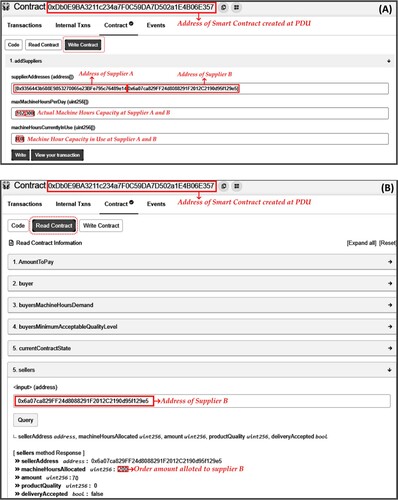
Figure 9. New block written on Ethereum blockchain.
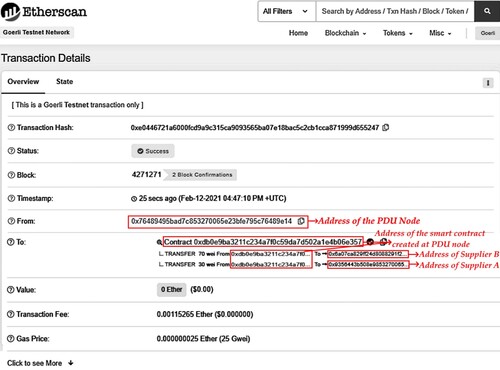
Using the Write Contract tab, unique addresses were given to suppliers A and B, their machine-hour capacity, and machine-hours for non-pre-emptive orders in the queue (Machine-hour capacity in use), as shown in (A). Note that addresses are in the form of encrypted public keys for the anonymous interaction of suppliers with the PDU node. Once all the contracts are hosted in the system, their written contract value will be extracted from the shared ledger on the individual buyer–supplier channel of the blockchain. Through the Read Contract feature, as shown in (B), the distribution of orders to each supplier can be checked by entering a supplier’s public key address. Once the evaluation is completed, the contract writes the order distribution details, including orders received by individual suppliers, as shown in .
4.6. Approximate computational costs
This study used an Ethereum blockchain because it is readily available for test runs. For a live version, it is recommended to develop and deploy a private and live production blockchain to reduce operational costs. Such infrastructure requires a significant investment; thus, the Ethereum blockchain is suitable for demonstration and pilot testing. The potential computational costs involved were identified following a process adopted from (Jabbar and Dani Citation2020), using Ethereum prices of 13 July 2021. Smart contract execution requires transaction mining, which varies depending on the resources available – that is, the load on the Ethereum blockchain network. In our case, the escrow contract spent around 0.0011 Ether, $2.32 gas was used in one scenario. In another instance, about 0.00021 Ether, $0.42 gas was used. The costs are also affected by the volatile Ether price, which complicates long-term cost planning. The mining cost evaluation shows that transaction costs are very low, and one has to conduct a very high number of transactions (i.e. millions) for costs to become prohibiting.
5. Discussion
Having developed the smart contract framework, three distinct but interrelated elements were identified that relate to the structure of the supply network, how it is used and how data is managed. These elements together promote collaboration and resource utilisation in supply networks using blockchain technology. Each element is discussed next.
5.1. Overall setup of the supply chain network in the proposed framework
As discussed in the literature section and also summarised in previous studies (Dubey et al. Citation2020; Chen et al. Citation2017; Soosay and Hyland Citation2015), there are significant benefits to collaborating in a supply network. These can be realised through the use of blockchain-based smart contracts that provide the dual advantages of open information sharing and access (Vatankhah Barenji et al. Citation2020; Dolgui et al. Citation2020) with the dynamic and competitive advantages of customised relations between select partners. In the developed partner interaction framework, we visualise the supply chain as an ecosystem with a complex network of collaborating partners. Even though the example given in was simplified, the framework functionality is applicable to complex networks. Each partner, including those at different tiers based on the distance from the OEM, acts as buyer and/or supplier, buying and/or supplying intermediate products from and to one or more partners. The network comprises multiple product channels through which intermediate products undergo the transformation and finally reach the OEM and the customers. The channels subdivide the network and enable the data partitioning mechanism. Each channel hosts its own smart contract(s) and stores data on the distributed ledger in encrypted form. Only authorised nodes within or outside the channel have read accessibility to the ledger data. This facilitates data privacy and ensures secure data management. Likewise, all data is stored on a common shared distributed ledger in encrypted form and only accessible to specific nodes with access rights. In general, suppliers may discourage information sharing among themselves to retain an information advantage or with buyers due to privacy and trust issues (Eurich, Oertel, and Boutellier Citation2010). As a result, buyers do not have insights into supplier manufacturing capacities, and orders are placed on financial terms. This leads to capacity overbooking, inappropriate distribution of orders, low resource utilisation and less desirable forms of subcontracting. Similarly, as suppliers have no visibility of buyer demand requirements, much of the surplus of low-quality rejected products remain unsold despite fulfilling requirements for other buyers. Addressing this issue of trust and low information sharing, the proposed framework stores data on the common distributed ledger, but the information cannot be decoded and read by all partners in the network. Information is not universally or equally accessible, and access is based on supply role and agreement between select parties. This creates a technology-based trust among the partners and facilitates sharing of crucial information for collaboration and resource sharing.
5.2. Role of procurement and distribution units
The developed framework uses blockchain technology to enhance collaboration. To keep all partners in one network while addressing trust and privacy issues, the blockchain network is divided into multiple channels, each connecting individual suppliers and buyers. This follows the approach followed by Agrawal et al. (Citation2021) for their study of textile supply chains. In practice, a single partner (buyer or supplier) can connect to multiple channels over the same blockchain network with a different channel for each buyer. Individual channels ensure privacy and prevent data sharing with competitor suppliers. The shared ledger records different transactions between the buyer and supplier. However, at the blockchain network-level each channel is connected to a procurement and distribution unit (PDU) that maintains the buyer demand record generated and the supplier demand distribution. It also contains a priority list of suppliers for each buyer and the acceptable product quality levels (AQL) of each buyer. The PDU ledger can be referred to for procurement and distribution order validation to ensure fair and efficient utilisation of resources. A smart contract of the PDU only accesses real-time supplier capacity data from individual channels and produces order quality levels. Thus, the whole network comprises multiple channels that ensure privacy and security. The PDU can only access limited data to ensure the effective distribution of demand and produced goods. The blockchain network created is decentralised and distributed, creating technology-based trust among its partners. The PDU should not be confused with a traditional central server in centralised networks. Rather, it is simply one or multiple nodes hosting a special smart contract with a set of rules for order procurement and distribution. This can be any authorised node belonging to any partner over the network and may even change for every transaction. The PDU is not controlled or hosted by a single party, it is based on mutually agreed utility and access between two or several parties. Unlike, other central servers, the PDU does not store data on central database. Although the PDU smart contract can access capacity and quality data, the identity of buyers and suppliers is encrypted and hidden using the public–private key mechanism and hash function.
5.3. Data management role
A crucial blockchain network element is the internal data management system at each unit (buyer or supplier). It is typically connected with sensors at each workstation, tracking and recording material flow, production time and process quality data during all production stages. This enhances visibility within the manufacturing unit by identifying bottlenecks and quality issues, as also advocated by Chiacchio et al. (Citation2020). It provides otherwise inaccessible data to the blockchain network. Note that a smart contract without blockchain functionality can ensure the validity of data before sharing them with the blockchain channel(s) through which suppliers connect to buyers. Data management is important because it provides off-chain data to the blockchain network (Longo et al. Citation2019). The data become the foundation for the entire blockchain network. It is the responsibility of each partner to ensure the right and timely data collection and storage in the data management system. It may even be advisable, if not necessary, to have an internal blockchain network for effective data collection in a data management system.
6. Conclusion
Collaboration and information sharing in the supply chain are important, especially given the need for sustainability and a circular economy that requires a comprehensive approach to supply chains and networks (Chen et al. Citation2017). Distributed ledger technologies are beneficial, moving from supply chains with single dominant actors to dynamic supply networks and business ecosystems (Angelis and Ribeiro da Silva Citation2019). In this study, we explored how blockchain-based networks and smart contracts function in supply networks to ensure collaboration among partners. A literature review presented existing studies and their contributions to blockchain use for supply information. A framework was developed that included the network diagram for information flow between actors in a blockchain-based collaborative network, a sequence diagram to demonstrate partners and smart contract interactions, the actual smart contract algorithm to define rules for order distribution and resource sharing and lastly, the deployment and verification of a smart contract on an Ethereum blockchain network. The study results show that smart contracts have the ability to incorporate customised rules that promote collaboration among select actors in the supply network and enable the sharing of resources among them. Using a case example, the developed sequence illustrates the message transfer and interaction sequence among the partners using smart contracts. It also shows how the contracts can effectively distribute demand orders from buyers to suppliers, and a finished product order in reverse, based on pre-set priority lists. Finally, by hosting and validating smart contracts in an actual blockchain environment, the study found that the proposed rules are applicable and workable in real industrial scenarios in which a private blockchain is employed in a supply chain network.
The paper has several key contributions. The paper provides insights into how to make use of smart contracts to enable participants in an extended supply chain network to capture the benefits of information sharing while retaining the benefits of customised or particular agreements and information sharing. The study does this by:
Expanding on the smart contract literature to identify key aspects relevant for such extended supply chains.
Show how smart contracts resolve the conflicts between increased collaboration and retained independence in terms of information and value capture.
Building a demonstrator that identifies the information sharing structure that is needed for the smart contracts to function. Network and sequence diagrams provide insights on how to design and implement such contracts in other supply chains and contexts.
Identifying how smart contracts may distribute demand and product orders according to priorities.
6.1. Contribution to theory
Supply networks are characterised by different types of actors, contracts and transactions. This study contributes to the existing literature on supply network collaboration by further detailing and discussing a key mechanism that supports such collaboration. A high degree of automated customisation of transactions and collaborations allows for greater efficiency and value capture. This necessitates a high degree of trust and the adoption of supporting technology. A majority of studies focus on financial or traceability-related transactions to ensure product provenance. This study expands the smart contract literature on applications to supply network collaboration. The results show how smart contracts resolve the conflicts between increased collaboration and retained independence in terms of information and value capture. Interrelated steps when using smart contracts not only help in increasing value capture but also broaden the inclusions of partners, for example, by improving the pricing mechanism and consequently market efficiency and market growth.
In addition to the literature on smart contracts and blockchain collaborative frameworks developed by Vatankhah Barenji et al. (Citation2020), Dolgui et al. (Citation2020), and Manupati et al. (Citation2020), we also consider partner preferences for customised networks and appropriate smart contract rules. Whereas the current blockchain literature typically emphasises mutually shared activities, the study results show that customised smart contract rules provide the dual benefit of supporting diverging interests while operating in a blockchain network that ensures unity and collaboration. This is beneficial for supply collaboration, since it provides greater flexibility than otherwise would be achievable.
6.2. Contribution to practice
The study results provide several insights to managers. Smart contracts are a useful tool for unlocking value beyond resource savings using blockchains (Salah et al. Citation2019). However, to be effective, they must be employed within an appropriate framework. In this, the PDU and data management system must be aligned to ensure that the required information sharing reaches relevant partners. In addition, the parties in the supply network must accept the duality of sharing information for a mutually shared gain, with the customised benefits of the specific deals that smart contracts provide. It is important to note that smart contracts are built on existing systems and rely on established data management systems. By adopting smart contracts, manufacturers can open up a more collaborative supply chain and a more comprehensive approach to business ecosystem partnerships, as also suggested by Angelis and Ribeiro da Silva (Citation2019). The framework and smart contracts proposed herein ensure product quality and data authenticity in supply networks that require highly accurate and authentic data, for instance, in pharmaceutical and food supply chains, where there is a dominant actor utilising many suppliers and sub-suppliers in an extensive network. Similarly, the developed framework ensures the effective utilisation of resources in networks where outsourcing and production surpluses are major issues, for instance, in textile supply chains which are highly criticised for unsustainable practices such as fraudulent transactions, capacity overbooking and illegitimate subcontracting.
6.3. Limitations and future work
The study is limited in that the proposed framework was not tested in an industrial context. Further, it did not incorporate an entire network or include factors related to multi-criteria decisions. Further research can be carried out to identify key factors that influence the collaborative models, including those related to social and environmental sustainability, as well as to provide input for comprehensive smart contracts with multi-criteria decision-making for improved order distribution. Another potential area for future research is to analyse transaction and maintenance cost-sharing on the blockchain network. Price sharing is subjected to power dynamics among the supply chain partners and varies for each transaction-based on the trading parties, so a detailed information and cost-sharing mechanism can be explored in a future study. Moreover, as data sharing among partners is a major concern due to privacy issues, the data components and their accessibility and visibility to specific actors should be identified and segregated.
Disclosure statement
No potential conflict of interest was reported by the author(s).
Data availability statement
The data that support the findings of this study are available from the corresponding author, [TKA], upon reasonable request.
Additional information
Funding
Notes on contributors

Tarun Kumar Agrawal
Tarun Kumar Agrawal is a Researcher in Production Logistics at KTH Royal Institute of Technology and Senior Lecturer in Logistics at the Chalmers University of Technology, Sweden. His research interest includes production logistic and supply chain information sharing, supply chain digitalisation, blockchain application in the manufacturing industry and data-driven decision-making. He graduated from ENSAIT, France with an M.Sc. in Industrial Systems Engineering (2015) and conducted his Ph.D. under Erasmus Mundus Fellowship by the European Commission. He holds Joint Doctorate (2019) in Production Automation from the University of Lille, France, Engineering from Soochow University, China and Textile Management from the University of Borås, Sweden.

Jannis Angelis
Jannis Angelis is a Reader in Operations Strategy at KTH Royal Institute of Technology, and researcher at the IFN Research Institute of Industrial Economics. He has a Ph.D. from Cambridge and previously explored strategy at Harvard, flexibility in knowledge-intensive firms at Stanford and Berkeley, lean at Cambridge and high-performance organisations at Oxford and MIT. Professional roles include work on export processing zones at the ILO (UN), associate director in a venture capital firm in London, and international consultant at the International Trade Centre (UN). Current research covers data-driven decision-making (e.g. algorithmic management) and blockchain use in food supply chains, forestry sustainability compliance and EV battery ecosystems.

Wajid Ali Khilji
Wajid Ali Khilji is a research engineer in production logistics at KTH Royal Institute of Technology since 2019. He has a mixed academic and industrial background. He received his Masters from Tartu University in 2014 and has worked with the software industry since 2009. His past work includes software development in Banking, ATM cards, finance, Education, Roads, commerce, house rentals, advertisement, Gnome, stocks, blockchain, CGI, Live TV, 3D virtualisation, digital twin system and industry 4.0. Have worked as CTO in a blockchain company before.

Ravi Kalaiarasan
Ravi Kalaiarasan, is an industrial Ph.D. student at KTH Royal Institute of Technology and employed at Scania CV. His research focuses on supply chain visibility for informed decision-making to improve supply chain performance. Prior to his doctoral studies, Ravi has been working within the automotive industry with work experiences in production, purchasing and IT. Ravi holds an M.Sc. in Production and Logistics from Mälardalens University.

Magnus Wiktorsson
Magnus Wiktorsson is a Professor of Production Logistics at KTH Royal Institute of Technology. His research interest concerns how complex production logistic systems can be described and predicted. The application areas are within the manufacturing industry, and his research is based on digitisation within supply chains and the need for transformation into environmentally sustainable production. Magnus Wiktorsson has a professional background with experience from business, government and universities. He graduated from the KTH Royal Institute of Technology in Stockholm with an M.Sc. in Systems Engineering (1995) and a Ph.D. in Manufacturing Engineering (2000). He is also head of the department for Sustainable Production Development as well as the department for Production Engineering at KTH.
References
- Agrawal, Tarun Kumar, Ravi Kalaiarasan, and Magnus Wiktorsson. 2020. “Blockchain-based Secured Collaborative Model for Supply Chain Resource Sharing and Visibility.” In Advances in Production Management Systems. The Path to Digital Transformation and Innovation of Production Management Systems, edited by Bojan Lalic, Vidosav Majstorovic, Ugljesa Marjanovic, Gregor von Cieminski, and David Romero, 259–266. Cham: Springer International Publishing.
- Agrawal, Tarun Kumar, Vijay Kumar, Rudrajeet Pal, Lichuan Wang, and Yan Chen. 2021. “Blockchain-based Framework for Supply Chain Traceability: A Case Example of Textile and Clothing Industry.” Computers & Industrial Engineering 154 (April): 107130.
- Alzahrani, Naif, and Nirupama Bulusu. 2020. “A New Product Anti-counterfeiting Blockchain Using a Truly Decentralized Dynamic Consensus Protocol.” Concurrency and Computation: Practice and Experience 32 (12): e5232.
- Angelis, Jannis, and Elias Ribeiro da Silva. 2019. “Blockchain Adoption: A Value Driver Perspective.” Business Horizons 62 (3): 307–314.
- Arnold, Ross D., and Jon P. Wade. 2015. “A Definition of Systems Thinking: A Systems Approach.” Procedia Computer Science 44: 669–678.
- Assaqty, M. I. S., Y. Gao, X. Hu, Z. Ning, V. C. M. Leung, Q. Wen, and Y. Chen. 2020. “Private-blockchain-Based Industrial IoT for Material and Product Tracking in Smart Manufacturing.” IEEE Network 34 (5): 91–97.
- Chen, Lujie, Xiande Zhao, Ou Tang, Lydia Price, Shanshan Zhang, and Wenwen Zhu. 2017. “Supply Chain Collaboration for Sustainability: A Literature Review and Future Research Agenda.” International Journal of Production Economics 194 (December): 73–87.
- Chiacchio, Ferdinando, Lucio Compagno, Diego D’Urso, Luca Velardita, and Philipp Sandner. 2020. “A Decentralized Application for the Traceability Process in the Pharma Industry.” Procedia Manufacturing 42: 362–369.
- Cricelli, Livio, Marco Greco, and Michele Grimaldi. 2021. “An Investigation on the Effect of Inter-Organizational Collaboration on Reverse Logistics.” International Journal of Production Economics 240 (October): 108216.
- Cui, Yao, Vishal Gaur, and Jingchen Liu. 2020. “Blockchain Collaboration with Competing Firms in a Shared Supply Chain: Benefits and Challenges.” SSRN Scholarly Paper ID 3626028. Rochester, NY: Social Science Research Network. https://papers.ssrn.com/abstract=3626028
- Dolgui, Alexandre, and Dmitry Ivanov. 2021. “5G in Digital Supply Chain and Operations Management: Fostering Flexibility, End-to-End Connectivity and Real-time Visibility Through Internet-of-Everything.” International Journal of Production Research 0 (0): 1–10.
- Dolgui, Alexandre, Dmitry Ivanov, Semyon Potryasaev, Boris Sokolov, Marina Ivanova, and Frank Werner. 2020. “Blockchain-oriented Dynamic Modelling of Smart Contract Design and Execution in the Supply Chain.” International Journal of Production Research 58 (7): 2184–2199.
- Dubey, Rameshwar, David J. Bryde, Cyril Foropon, Manisha Tiwari, Yogesh Dwivedi, and Sarah Schiffling. 2021. “An Investigation of Information Alignment and Collaboration as Complements to Supply Chain Agility in Humanitarian Supply Chain.” International Journal of Production Research 59 (5): 1586–1605.
- Dubey, Rameshwar, Angappa Gunasekaran, David J. Bryde, Yogesh K. Dwivedi, and Thanos Papadopoulos. 2020. “Blockchain Technology for Enhancing Swift-trust, Collaboration and Resilience Within a Humanitarian Supply Chain Setting.” International Journal of Production Research 58 (11): 3381–3398.
- Duong Linh Nguyen Khanh, Chong Josephine. 2020. “Supply Chain Collaboration in the Presence of Disruptions: A Literature Review.” International Journal of Production Research 58 (0): 3488–3507.
- Eurich, Markus, Nina Oertel, and Roman Boutellier. 2010. “The Impact of Perceived Privacy Risks on Organizations’ Willingness to Share Item-level Event Data across the Supply Chain.” Electronic Commerce Research 10 (3): 423–440.
- Fuller, Jack, Michael G Jacobides, and Martin Reeves. 2019. “The Myths and Realities of Business Ecosystems.” MIT Sloan Management Review 60 (3): 1–9.
- Gao, Kui, Yang Liu, Heyang Xu, and Tingting Han. 2020. “Design and Implementation of Food Supply Chain Traceability System Based on Hyperledger Fabric.” International Journal of Computational Science and Engineering 23 (2): 185.
- Gaur, Vishal, and Abhinav Gaiha. 2020. “Building a Transparent Supply Chain.” Harvard Business Review, May 1. https://hbr.org/2020/05/building-a-transparent-supply-chain
- Gebhardt, Maximilian, Matthias Kopyto, Hendrik Birkel, and Evi Hartmann. 2021. “Industry 4.0 Technologies as Enablers of Collaboration in Circular Supply Chains: A Systematic Literature Review.” International Journal of Production Research 0 (0): 1–29.
- Govindan, Kannan, Arash Khalili Nasr, Mohammad Saeed Heidary, Saeede Nosrati-Abarghooee, and Hassan Mina. 2022. “Prioritizing Adoption Barriers of Platforms Based on Blockchain Technology from Balanced Scorecard Perspectives in Healthcare Industry: A Structural Approach.” International Journal of Production Research 0 (0): 1–15.
- Graça, Paula, and Luís M. Camarinha-Matos. 2017. “Performance Indicators for Collaborative Business Ecosystems — Literature Review and Trends.” Technological Forecasting and Social Change 116 (C): 237–255.
- Grzybowska, Katarzyna, and Anjali Awasthi. 2020. “Literature Review on Sustainable Logistics and Sustainable Production for Industry 4.0.” In Sustainable Logistics and Production in Industry 4.0: New Opportunities and Challenges, edited by Katarzyna Grzybowska, Anjali Awasthi, and Rapinder Sawhney, 1–18. Cham: Springer International Publishing.
- Ivanov, Dmitry, Alexandre Dolgui, and Boris Sokolov. 2019. “The Impact of Digital Technology and Industry 4.0 on the Ripple Effect and Supply Chain Risk Analytics.” International Journal of Production Research 57 (3): 829–846.
- Jabbar, Abdul, and Samir Dani. 2020. “Investigating the Link Between Transaction and Computational Costs in a Blockchain Environment.” International Journal of Production Research 58 (11): 3423–3436.
- Jraisat, Luai, Arvind Upadhyay, Thaana Ghalia, Mohannad Jresseit, Vikas Kumar, and David Sarpong. 2021. “Triads in Sustainable Supply-chain Perspective: Why Is a Collaboration Mechanism Needed?” International Journal of Production Research 0 (0): 1–17.
- Karakas, Serkan, Avni Zafer Acar, and Berk Kucukaltan. 2021. “Blockchain Adoption in Logistics and Supply Chain: A Literature Review and Research Agenda.” International Journal of Production Research 0 (0): 1–24.
- Kim, Henry M., and Marek Laskowski. 2018. “Toward an Ontology-driven Blockchain Design for Supply-chain Provenance.” Intelligent Systems in Accounting, Finance and Management 25 (1): 18–27.
- Kochovski, Petar, Sandi Gec, Vlado Stankovski, Marko Bajec, and Pavel D. Drobintsev. 2019. “Trust Management in a Blockchain Based Fog Computing Platform with Trustless Smart Oracles.” Future Generation Computer Systems 101 (December): 747–759.
- Kruchten, P. B. 1995. “The 4+1 View Model of Architecture.” IEEE Software 12 (6): 42–50.
- Kumar, Ajay, Kumar Abhishek, Pranav Nerurkar, Muhammad Rukunuddin Ghalib, Achyut Shankar, and Xiaochun Cheng. 2020. “Secure Smart Contracts for Cloud-based Manufacturing Using Ethereum Blockchain.” Transactions on Emerging Telecommunications Technologies, 4129.
- Li, Ming, Yelin Fu, Qiqi Chen, and Ting Qu. 2021. “Blockchain-Enabled Digital Twin Collaboration Platform for Heterogeneous Socialized Manufacturing Resource Management.” International Journal of Production Research 0 (0): 1–21.
- Li, Zhi, Hanyang Guo, Ali Vatankhah Barenji, W. M. Wang, Yijiang Guan, and George Q. Huang. 2020. “A Sustainable Production Capability Evaluation Mechanism Based on Blockchain, LSTM, Analytic Hierarchy Process for Supply Chain Network.” International Journal of Production Research 58 (24): 7399–7419.
- Lin, Q., H. Wang, X. Pei, and J. Wang. 2019. “Food Safety Traceability System Based on Blockchain and EPCIS.” IEEE Access 7: 20698–20707.
- Liu, Lu, Yongjian Li, and Tao Jiang. 2021. “Optimal Strategies for Financing a Three-level Supply Chain Through Blockchain Platform Finance.” International Journal of Production Research 0 (0): 1–18.
- Longo, Francesco, Letizia Nicoletti, Antonio Padovano, Gianfranco d’Atri, and Marco Forte. 2019. “Blockchain-enabled Supply Chain: An Experimental Study.” Computers & Industrial Engineering 136 (October): 57–69.
- Manimuthu, Arunmozhi, V. G. Venkatesh, Yangyan Shi, V. Raja Sreedharan, and S. C. Lenny Koh. 2021. “Design and Development of Automobile Assembly Model Using Federated Artificial Intelligence with Smart Contract.” International Journal of Production Research 0 (0): 1–25.
- Manupati, V. K., Tobias Schoenherr, M. Ramkumar, Suraj Panigrahi, Yash Sharma, and Prakriti Mishra. 2022. “Recovery Strategies for a Disrupted Supply Chain Network: Leveraging Blockchain Technology in Pre- and Post-disruption Scenarios.” International Journal of Production Economics 245 (March): 108389.
- Manupati, V. K., Tobias Schoenherr, M. Ramkumar, Stephan M. Wagner, Sai Krishna Pabba, and R. Inder Raj Singh. 2020. “A Blockchain-based Approach for a Multi-echelon Sustainable Supply Chain.” International Journal of Production Research 58 (7): 2222–2241.
- Mao, Dianhui, Fan Wang, Zhihao Hao, and Haisheng Li. 2018. “Credit Evaluation System Based on Blockchain for Multiple Stakeholders in the Food Supply Chain.” International Journal of Environmental Research and Public Health 15 (8): 1627.
- Muller, Christina, Marcus Brandenburger, Christian Cachin, Pascal Felber, Christian Gottel, and Valerio Schiavoni. 2020. “TZ4Fabric: Executing Smart Contracts with ARM TrustZone: (Practical Experience Report),” 2020 International Symposium on Reliable Distributed Systems (SRDS), pp. 31–40.
- Perera, T., S. P. Thewa Hettige, S. A. P. Jayatilake, W. Abeygunawardhana, and H. M. N. Dilum Bandara. 2020. “Blockchain-Based Product Traceability Beyond Proof of Existence.” In 2020 Moratuwa Engineering Research Conference (MERCon), 1–6.
- Pournader, Mehrdokht, Yangyan Shi, Stefan Seuring, and S. C. Lenny Koh. 2020. “Blockchain Applications in Supply Chains, Transport and Logistics: A Systematic Review of the Literature.” International Journal of Production Research 58 (7): 2063–2081.
- Rahmanzadeh, Sajjad, Mir Saman Pishvaee, and Mohammad Reza Rasouli. 2020. “Integrated Innovative Product Design and Supply Chain Tactical Planning Within a Blockchain Platform.” International Journal of Production Research 58 (7): 2242–2262.
- Ribeiro da Silva, Elias Hans Dener, Jannis Angelis, and Edson Pinheiro de Lima. 2019. “In Pursuit of Digital Manufacturing.” Procedia Manufacturing 28: 63–69.
- Saberi, Sara, Mahtab Kouhizadeh, Joseph Sarkis, and Lejia Shen. 2019. “Blockchain Technology and Its Relationships to Sustainable Supply Chain Management.” International Journal of Production Research 57 (7): 2117–2135.
- Sahoo, Swagatika, and Raju Halder. 2020. “Blockchain-based Forward and Reverse Supply Chains for E-waste Management.” In Future Data and Security Engineering, edited by Tran Khanh Dang, Josef Küng, Makoto Takizawa, and Tai M. Chung, 201–220. Cham: Springer International Publishing.
- Salah, K., N. Nizamuddin, R. Jayaraman, and M. Omar. 2019. “Blockchain-based Soybean Traceability in Agricultural Supply Chain.” IEEE Access 7: 73295–73305.
- Shahbazi, Zeinab, and Yung-Cheol Byun. 2021. “A Procedure for Tracing Supply Chains for Perishable Food Based on Blockchain, Machine Learning and Fuzzy Logic.” Electronics 10 (1): 41.
- Sharma, P. K., N. Kumar, and J. H. Park. 2019. “Blockchain-based Distributed Framework for Automotive Industry in a Smart City.” IEEE Transactions on Industrial Informatics 15 (7): 4197–4205.
- Shermin, Voshmgir. 2017. “Disrupting Governance with Blockchains and Smart Contracts.” Strategic Change 26 (5): 499–509.
- Soosay, Claudine Antoinette, and Paul Hyland. 2015. “A Decade of Supply Chain Collaboration and Directions for Future Research.” Supply Chain Management: An International Journal 20 (6): 613–630.
- Swan, Melanie. 2015. Blockchain: Blueprint for a New Economy. Sebastopol, CA: O’Reilly Media, Inc.
- Szabo, Nick. 2016. “Smart Contracts: 12 Use Cases for Business & Beyond A Technology, Legal & Regulatory Introduction.” Washington, D.C., United States: Chamber of Digital Commerce. https://digitalchamber.org/chamber-of-digital-commerce-releases-smart-contracts-white-paper/
- Tang, Liang, Huanying Han, Zhen Tan, and Ke Jing. 2021. “Centralized Collaborative Production Scheduling with Evaluation of a Practical Order-merging Strategy.” International Journal of Production Research 0 (0): 1–20.
- Vatankhah Barenji Ali, Zhi Li, W. M. Wang, George Q. Huang, and David A. Guerra-Zubiaga. 2020. “Blockchain-based Ubiquitous Manufacturing: A Secure and Reliable Cyber-physical System.” International Journal of Production Research 58 (7): 2200–2221.
- Venkatesh, V. G., Kai Kang, Bill Wang, Ray Y Zhong, and Abraham Zhang. 2020. “System Architecture for Blockchain Based Transparency of Supply Chain Social Sustainability.” Robotics and Computer-integrated Manufacturing 63 (June): 101896.
- Wang, Hongfeng, Qi Yan, and Junwei Wang. 2021. “Blockchain-secured Multi-factory Production with Collaborative Maintenance Using Q Learning-based Optimisation Approach.” International Journal of Production Research 0 (0): 1–18.
- Westerkamp, Martin, Friedhelm Victor, and Axel Küpper. 2020. “Tracing Manufacturing Processes Using Blockchain-based Token Compositions.” Digital Communications and Networks 6 (2): 167–176.
- Xu, Zhijun, Jun Zhang, Zhaoxiong Song, Yichen Liu, Jun Li, and Jihua Zhou. 2021. “A Scheme for Intelligent Blockchain-based Manufacturing Industry Supply Chain Management.” Computing 103 (8): 1771–1790.
- Yu, Min-Chun, and Mark Goh. 2014. “A Multi-Objective Approach to Supply Chain Visibility and Risk.” European Journal of Operational Research 233 (1): 125–130.
- Zhou, Liping, Zhibin Jiang, Na Geng, Yimeng Niu, Feng Cui, Kefei Liu, and Nanshan Qi. 2021. “Production and Operations Management for Intelligent Manufacturing: A Systematic Literature Review.” International Journal of Production Research 0 (0): 1–39.

